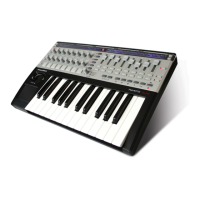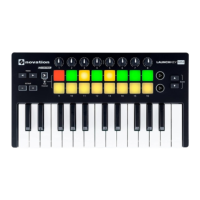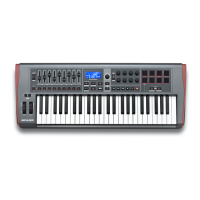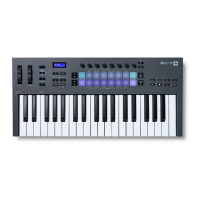25
Pressing the MODULATION button [17] opens the Modulation Menu, which is a single
page. The menu may be visualised as a system for connecting controlling sources to a
specific area of the synth. Each such connection assignment is termed a ‘slot’, and there
are 20 such slots, accessed by RE1 (see below). Each slot defines how one or two control
sources are routed to a controlled parameter. The routing possibilities available in each of
the 20 slots are identical, and the control description below is applicable to all of them.
The Modulation Matrix is both variable and additive. What do we mean by a
‘variable’ and ‘additive’ matrix?
By ‘variable’, we mean that it is not just the routing of a controlling source to a controlled
parameter which is defined in each slot, but also the “magnitude” of the control. Thus the
‘amount’ of control – or control ‘range’ – used is up to you.
By ‘additive’ we mean that a parameter may be varied by more than one source, if wished.
Each slot allows for two sources to be routed to a parameter, and their effects are
multiplied together. This means that if either of them is at zero, there will be no modula-
tion. However, there is no reason why you can’t have further slots routing these or other
sources to the same parameter. In this case, the control signals from different slots “add” to
produce the overall effect.
Mod Wheel Position
You need to be careful when setting up patches like this to ensure that the com-
bined effect of all the controllers acting simultaneously still creates the sound
that you want.
In addition, the Modulation Menu lets you assign the touch-sensitive knobs on any of the
eight rotary encoders as additional controllers, so as long as the Animate Touch mode is
enabled (see page 26).
Modulation Matrix Menu
RE1: Patch number
Displayed as: Number
Initial value: 1
Range of adjustment: 1 to 20
The Modulation Matrix has 20 ‘slots’, each defining a routing assignment of one (or two)
sources to a destination. All the patches have the same selection of sources and destina-
tions and any or all can be used. The same source can control multiple destinations, and
one destination can be controlled by multiple sources.
LFO 1 parameters (Page 2)
RE1: LFO 1 Delay
Displayed as: L1Delay
Initial value: 0
Range of adjustment: 0 to 127
LFO Delay is a time parameter whose function is determined by L1InOut (RE3).
RE2: LFO 1 Delay Sync
Displayed as: L1DSync
Initial value: Off
Range of adjustment: See table at page 40.
When this parameter is set to Off, the LFO delay is controlled by the Delay parameter
(RE1). At all other settings RE1 becomes inoperative, and the LFO delay is derived from
the internal/external MIDI clock.
RE3: LFO 1 Fade In/Fade Out
Displayed as: L1InOut
Initial value: FadeIn
Range of adjustment: FadeIn, FadeOut, GateIn, GateOut
The function of the four possible settings of Intro are as follows:
FadeIn - the LFO’s modulation is gradually increased over the time period set by the Delay
parameter (RE1).
GateIn – the onset of the LFO’s modulation is delayed by the time period set by the LFO
Delay parameter, and then starts immediately at full level.
FadeOut – the LFO’s modulation is gradually decreased over the time period set by the
Delay parameter (RE1), leaving the note with no LFO modulation.
GateOut – the note is fully modulated by the LFO for the time period set by the Delay
parameter (RE1). At this time, the modulation stops abruptly.
RE4: LFO1 Delay Trigger
Displayed as: L1DTrig
Initial value: Legato
Range of adjustment: Legato or Re-Trig
This parameter works in conjunction with the Fade In/Fade Out function set by RE3. In
Re-Trig mode, every note played has its own delay time, as set by the Delay parameter (or
MIDI clock if L1Dsync is active). In Legato mode, it is only the first note of a legato-style
passage which determines the Delay time – i.e. second and subsequent notes do not re-
trigger the Delay function. For the Legato setting of Delay Trigger to be operative, mono
voicing must be selected – it will not work with polyphonic voicing. See page 18.
See page 21 for more details about Legato style.
RE5-RE8: Not used
the moDulatIon matrIx
The heart of a versatile synthesizer lies in the ability to interconnect the various controllers,
sound generators and processing blocks such that one is controlling – or “modulating” -
another, in as many ways as possible. UltraNova provides tremendous flexibility of control
routing, and there is a dedicated menu for this, the Modulation Menu.
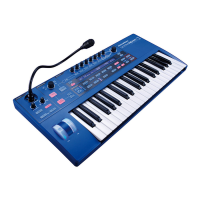
